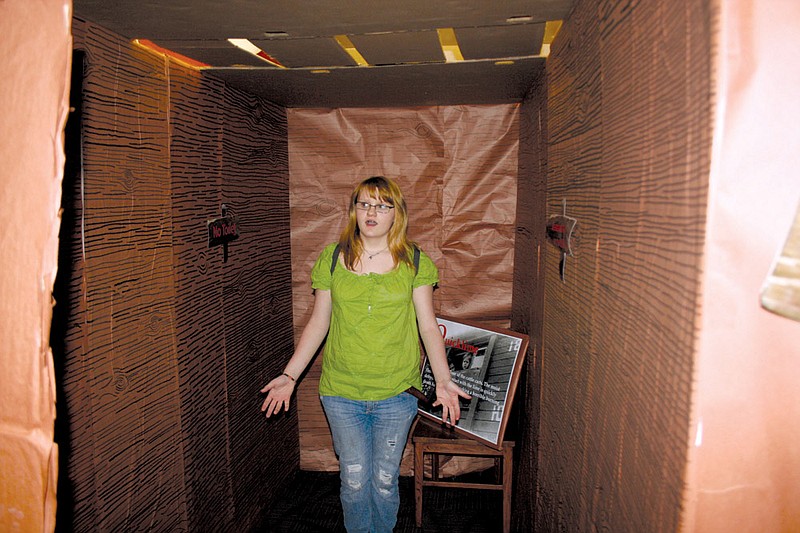It was startling to walk into Malvern Middle School last week.
From the front door, a quick glance to the right and the eye stops on the red flag on a pillar near the stairwell. In a stark, white circle in the red banner is the black swastika made infamous by the Nazi Party.
Farther down the hall are pictures of the death camps they operated. On the left is the uniform of a camp guard, as well as a small replica of the striped uniform of an inmate from one of those camps.
All around are schoolchildren, learning about the horrors done to people during what became known as the Holocaust. Other young people — none more than 14 years old — teach the lessons.
The sights and lessons are part of a mini Holocaust museum that some 70 eighth- and ninth-grade students made in the school’s hallways and library under the direction of English teacher Claudine James, Environmental and Spatial Technology teacher Chris Slaton and art teacher Kenzy Couron.
In a corner of the school library stands Emma Callahan, 14. She resides in a dark enclosure representative of the railroad cars, designed for cattle, that carried millions of men, women and children to the concentration camps from the late 1930s until the liberation of Europe in 1945.
“The people were packed in with almost no room to move,” Emma explained to a group of fifth-graders from Wilson Intermediate School in Malvern. “If someone died next to you during the trip, it was sometimes impossible to lay them down. There was no room, so the body stayed upright and rubbed against you.”
She said she stepped inside a real cattle car at the United States Holocaust Memorial Museum in Washington, D.C., while she was visiting her aunt in Maryland last summer.
“It makes me feel special to be a part of this museum we have built here,” Emma said.
Across the hall and up a stairway at the middle school, Shirniya Carter, 14, tells another class of fifth-graders about the posters on the wall.
The posters include photos of Auschwitz-Birkenau, Treblinka and Belzec, where millions were exterminated for being accused of being politically, racially or socially unfit to live in the German Reich.
Shirniya pointed out that the Nazis killed as many as 6 million Jews, but also targeted Gypsies, homosexuals, many Catholics and Jehovah’s Witnesses — all considered undesirables.
“It hurts to think about it,” she said, “that someone could change people’s minds about a race of people or anyone who was different and teach hating them.”
Wilson fifth-grader Kennedy Fogleman was watching Morgan Lee of Malvern Middle School tell her and her classmates about how Anne Frank, a Jewish girl in Holland, hid from the Nazis for more than two years in a secret annex of her neighbor’s house in Amsterdam.
“We have studied about this in science, and we watched a movie and read a book in English class,” Kennedy said.
Carol Morris, a teacher at Wilson, said approximately 75 students had taken a bus to the middle school to see the exhibit.
“The children are interested and paying attention,” she said. “This is wonderful work the kids are doing.”
Like any good school project, a book inspired the mini museum.
Claudine James, who teaches eighth-grade pre-AP English, said that in 1983 after reading The Winds of War by Herman Wouk, she became an impassioned student of the Holocaust.
Last summer, she visited the Holocaust Museum as part of a summer learning program for teachers. James said the story of the Holocaust is more than a history lesson; it carries a lesson important in today’s schools.
“All this,” she said, looking at the exhibits, “is about bullying. Some people have said, ‘Couldn’t we have found something else to highlight?’ but this is the biggest bully of all time, Adolf Hitler, and what bullying can lead to in the world.”
James said a student who toured the school museum learned an important message.
“She told me that in the bus on the way back to her school she had seen someone being bullied,” James said. “Then she said, ‘I thought about what I had seen and I knew I could not be a bystander and I reported it when I got to school.’ We talk about bystanders in our tour, how people in Germany and other countries saw what was happening — and did nothing.”
Following her return from the national museum, James applied for grants to create an exhibition at the school.
“Originally, this was going to be a book exhibit and students would talk about the books they read about the Holocaust,” James said. “We ended up with 45 different projects.”
She also said the project was first to only include eighth-graders.
“But some of the seventh-graders didn’t want to be left out,” James said.
James praised the work of teacher Slaton and his EAST class.
“He has been a perfect co-teacher,” she said. “He gave us the technology to get the story out.”
The students plan to make a documentary about the lessons they’ve learned creating the exhibition.
“As a teacher,” James said, “it has been so great to see my students evolve into mature, civic-minded adults.”
For more information,
contact Malvern Middle School at (501) 332-7530.
Staff writer Wayne Bryan can be reached at (501) 244-4460 or wbryan@arkansasonline.com.
